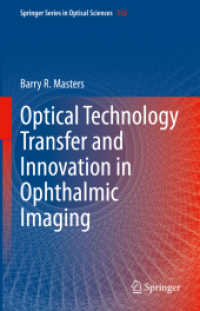- ホーム
- > 洋書
- > ドイツ書
- > Mathematics, Sciences & Technology
- > Biology
- > botanics
基本説明
The initial chapters use an organismic-based approach by concentrating on the well-characterized diazotrophic proteobacteria, etc. The later chapters use a comparative process-based approach and serve as overviews dealing with different regulatory aspects, etc.
Full Description
Genetics and Regulation of Nitrogen-Fixing Bacteria This book is the second volume of a seven-volume series, which covers all fields of research related to nitrogen fixation - from basic studies through applied aspects to environmental impacts. Volume II provides a comprehensive and detailed source of information concerning the genetics and regulation of biological nitrogen fixation in free-living prokaryotes. This preface attempts to provide the reader with some insight into how this volume originated, how it was planned, and then how it developed over the several years of its production. Once the editorial team was established, the first job was to decide which of the many free-living diazotrophs that have been subjected to genetic analysis should be included in this volume. Would we need to develop specific criteria for selection or would the organisms, in effect, select themselves? Of course, Klebsiella pneumoniae and Azotobacter vinelandii, which have served (and still serve) as the main model organisms for the genetic analysis of diazotrophy, plus some of the other bacteria described in this volume, did indeed select themselves. However, there was considerable discussion surrounding well-characterized fixing species, like Azorhizobium caulinodans and Herbaspirillum seropedicae, both of which are able to fix atmospheric N under free-living conditions.
Contents
Historical Perspective — Development of nif Genetics and Regulation in Klebsiella pneumoniae.- Genetics of Nitrogen Fixation and Related Aspects of Metabolism in Species of Azotobacter: History and Current Status.- Nitrogen Fixation in the Clostridia.- Regulation of Nitrogen Fixation in Methanogenic Archaea.- Nitrogen Fixation in Heterocyst-Forming Cyanobacteria.- N2 Fixation by Non-Heterocystous Cyanobacteria.- Nitrogen Fixation in the Photosynthetic Purple Bacterium Rhodobacter capsulatus.- Post-Translational Regulation of Nitrogenase in Photosynthetic Bacteria.- Regulation of Nitrogen Fixation in Free-Living Diazotrophs.- Molybdenum Uptake and Homeostasis.- Electron Transport to Nitrogenase: Diverse Routes for a Common Destination.- Prospects.








